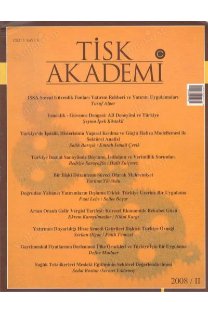Spekülasyon ve emtia fiyatları üzerine bir not
A note on speculation and commodity prices
___
- Caballero, R. J., Farhi E. ve Gourinchas, P.O. (2006). An Equilibrium Model of Global Imbalances and Low Interest Rates. NBER Working Papers 11996. National Bureau of Economic Research, Inc.
- De Schutter, O. (2010). Food Commodities Speculation and Food Price Crisis. UN Special Rapporteur on the Right to Food Briefing note 02. United Nations.
- Gilbert, C. L. (2008). Commodity Speculation and Commodity Investment. Discussion Paper 20. Universita Degli Studi di Trento.
- Hamilton, J. D. (2008). Understanding Crude Oil Prices. NBER Working Papers 14492. National Bureau of Economic Research, Inc.
- Hamilton, J. D. (2009). Causes and Consequences of the Oil Shock of 2007-08. NBER Working Papers 15002. National Bureau of Economic Research, Inc.
- Hotelling, H. (1931). The Economics of Exhaustible Resources. Journal of Political Economy. Vol.39, No.2, 137-175.
- IMF (2008a). Assessing Risks to Global Financial Stability. Global Financial Stability Report. Chapter 1, 62-66.
- IMF (2008b). Does Financial Investment Affect Commodity Price Behavior. World Economic Outlook. Chapter 3, Box 3.1, 88-93.
- Jovanovic, B. (2007). Bubbles in Prices of Exhaustible Resources. NBER Working Papers 13320. National Bureau of Economic Research, Inc.
- Kaldor, N. (1939). Speculation and Economic Stability. Review of Economic Studies. Vol. VII (Oct.), 1-27.
- Krugman, P. (2008). Speculation and Signatures. http://www.princeton.edu/~pkrug-man/Speculation%20and%20Signatures.pdf 10 Temmuz 2011 tarihinde erişildi.
- Orman, C., Öğünç, F., Saygılı, Ş., Yılmaz, G. (2010). İşlenmemiş Gıda Fiyatlarında Oynaklığa Yol Açan Yapısal Faktörler. Ekonomi Notları. Sayı: 2010-16, Türkiye Cumhuriyet Merkez Bankası.
- Timmer, C. P. (2009). Rice Price Formation in the Short Run and the Long Run. Technical Report 172. Center for Global Development.
- Working, H. (1949). The Theory of Price of Storage. The American Economic Review. Vol.39, No.6. 1254-1262.
- ISSN: 1306-6757
- Yayın Aralığı: 2
- Başlangıç: 2006
- Yayıncı: Türkiye Isveren Sendikalari Konfederasyonu
Türk borçlar kanunu’nda hizmet sözleşlmelerinin tanımı ve kurulması
Yerel yönetim düzeyinde mali kural uygulaması ve Türkiye değerlendirmesi
İsmail Orçun GÜNDÜZ, BİLGE HAKAN AGUN
Türkiye ve OECD ülkelerinin insani gelişme bakımından karşılaştırılması (1980-2010)
Merve Yasemin TEKBUDAK, Hüseyin TATLIDİL
İşyerinde ayrımcılık:Kavramsal bir inceleme
